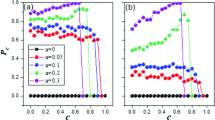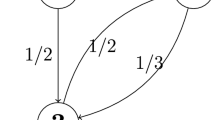Abstract
The study of opinion dynamics model on social networks is one of the hot spots in the field of social sciences. In this paper, we propose a generalized opinion dynamics model, which dynamically compute each person’s expressed opinion, to solve the opinion maximization problem for social trust networks. In the model, we propose a new, reasonable and interpretable confidence index \(\alpha _i\), which is different from randomly selected \(\alpha _i\) and is determined by both person’s social status and the evaluation of his/her predecessors. By using the theory of diagonally dominant, we obtain the optimal analytic solution of the Nash equilibrium with maximum overall opinion. In addition, we design an efficient traditional ADMM algorithm with \(l_1\)-regulations to maximize the overall opinion. A series of experiments are conducted, and the experimental results show that the proposed model is superior to the state-of-the-art in four datasets. The average benefit has promoted \(67.5\%\), \(83.2\%\), \(31.5\%\), and \(33.7\%\) in solving the internal opinion problem and \(215.2\%\), \(225.1\%\), \(33.0\%\), \(21.2\%\) in solving the expressed opinion problems on four datasets, respectively.









Similar content being viewed by others
Data availibility
The datasets generated during and analysed during the current study are available in the [SNAP] repository, http://snap.stanford.edu/data/.
References
Abebe1 R, Kleinberg J, Parkes D, TsourakakisRediet CE (2018) Opinion dynamics with varying susceptibility to persuasion. In: 24th ACM SIGKDD international conference on knowledge discovery and data mining, pp 1089–1098
Agarwal Y, Sharma DK, Katarya R (2019) Sentiment/opinion review analysis: detecting spams from the good ones! In: 4th International conference on information systems and computer networks (ISCON)
Berman A, Plemmons RJ (1994) Nonnegative matrices in the mathematical sciences. Soc Ind Appl Math 35(1)
Bhatia B, Verma A, Anjum, Katarya R (2021) Analysing cyberbullying using natural language processing by understanding Jargon in social media
Bindel D, Kleinberg J, Oren S (2015) How bad is forming your own opinion. Games Econ Behav 92:248–265
Boyd S, Parikh S, Chu E, Peleato B, EcksteinStephen J (2010) Distributed optimization and statistical learning via the alternating direction method of multipliers. Found Trends Mach Learn 3(1):1–122
Chen S, Fan J, Li G, Feng J, Tan K, Tang J (2015) Online topic-aware influence maximization. Proc VLDB Endow 8(6):666–677
Friedkin NE, JohnsenNoah EC (1990) Social influence and opinions. J Math Sociol 15(3–4):193–206
Gabay D, Mercier B (1976) A dual algorithm for the solution of nonlinear variational problems via finite element approximation. Comput Math Appl 2(1):17–40
Garg S, Panwar DS, Gupta A, Katarya R (2020) A literature review on sentiment analysis techniques involving social media platforms. In: Sixth international conference on parallel, distributed and grid computing
Gupta A, Katarya R (2020) Social media based surveillance systems for healthcare using machine learning: a systematic review. J Biomed Inform 108:103500
Jain L, Katarya R (2018) A systematic survey of opinion leader in online social network. In: International conference on soft-computing and network security (ICSNS)
Katarya R, Arora Y (2020) Capsmf: a novel product recommender system using deep learning based text analysis model. Multimed Tools Appl 79(3):35927–35948
Katarya R, Massoudi M (2020) Recognizing fake news in social media with deep learning: a systematic review. In: 4th International conference on computer, communication and signal processing (ICCCSP)
Kumar S, Hooi B, Makhija D, Kumar M, Faloutsos C, Subrahmanian VS (2018) Rev2: fraudulent user prediction in rating platforms. In: 11th ACM international conference on web search and data mining, pp 333–341
Kumar S, Spezzano F, Subrahmanian VS, Faloutsos C (2017) Edge weight prediction in weighted signed networks. In: IEEE international conference on data mining
Li Y, Chen W, Wang Y, Zhang Z (2013) Influence diffusion dynamics and influence maximization in social networks with friend and foe relationships. In: 6th ACM international conference on Web search and data mining, pp 657–666
Liu F, Wu J, Xue S, Zhou C, Yang J, Sheng Q (2020b) Detecting the evolving community structure in dynamic social networks. World Wide Web 23:715–733
Liu X, Kong X, Yu PS (2018) Active opinion maximization in social networks. In: 24th ACM SIGKDD international conference on knowledge discovery and data mining, pp 1840–1849
Liu F, Xue S, Wu J, Zhou C, Hu W, Paris C, Nepal S, Yang J, Yu PS (2020a) Deep learning for community detection: progress, challenges and opportunities. In: Twenty-ninth international joint conference on artificial intelligence and seventeenth Pacific rim international conference on artificial intelligence
Ma X, Wu J, Xue S, Yang J, Zhou C, Sheng Q Z, Xiong H, Akoglu L (2021) A comprehensive survey on graph anomaly detection with deep learning
Musco C, Musco C, Tsourakakis CE (2018) Minimizing polarization and disagreement in social networks. In: The 2018 World Wide Web conference, pp 369–378
Page L (1998) The pagerank citation ranking: bringing order to the web
Su X, Xue S, Liu F, Wu J, Yang J, Zhou Z, Hu W, Paris C, Nepal S, Jin D, Sheng QZ, Yu PS (2021) A comprehensive survey on community detection with deep learning
West R, Paskov HS, Leskovec J, PottsRobert C (2014) Exploiting social network structure for person-to-person sentiment analysis. Trans Assoc Comput Linguist 2:297–310
Xu P, Hu W, Wu J, Liu W (2020) Opinion maximization in social trust networks. In: 29th International joint conference on artificial intelligence
Funding
This work was supported by National Natural Science Foundation of China (Grant No. 1901145) and Shanghai Planning Project of Philosophy and Social Science (Grant No. 2019EGL010).
Author information
Authors and Affiliations
Contributions
All authors contributed to the study conception and design. Material preparation, data collection and analysis were performed by CH, JZ and SL. The first draft of the manuscript was written by CH and JZ. The model was proposed by GZ and all authors commented on previous versions of the manuscript. All authors read and approved the final manuscript.
Corresponding author
Ethics declarations
Competing interest
The authors have no relevant financial or non-financial interests to disclose.
Additional information
Publisher's Note
Springer Nature remains neutral with regard to jurisdictional claims in published maps and institutional affiliations.
Rights and permissions
Springer Nature or its licensor holds exclusive rights to this article under a publishing agreement with the author(s) or other rightsholder(s); author self-archiving of the accepted manuscript version of this article is solely governed by the terms of such publishing agreement and applicable law.
About this article
Cite this article
He, C., Zeng, J., Zhang, G. et al. Generalized opinion dynamics model for social trust networks. J Comb Optim 44, 3641–3662 (2022). https://doi.org/10.1007/s10878-022-00913-7
Accepted:
Published:
Issue Date:
DOI: https://doi.org/10.1007/s10878-022-00913-7




